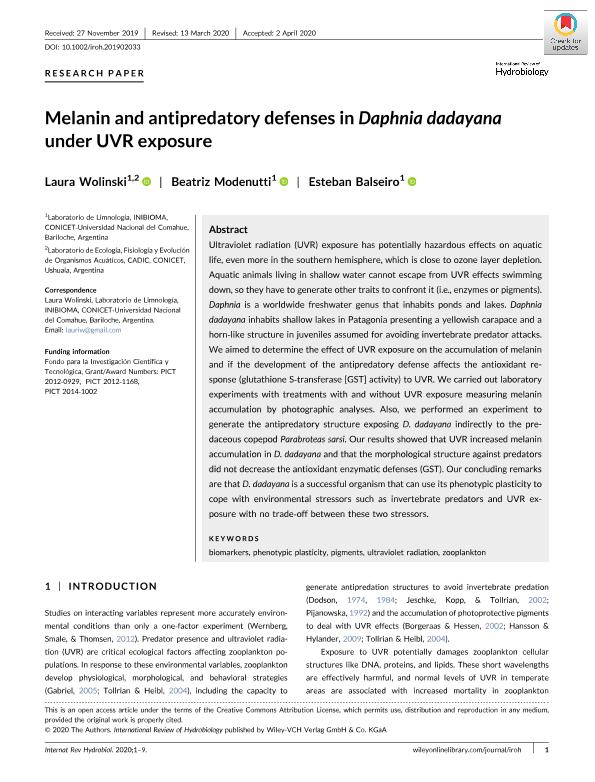Artículo
Melanin and antipredatory defenses in Daphnia dadayana under UVR exposure
Fecha de publicación:
04/2020
Editorial:
Wiley VCH Verlag
Revista:
International Review of Hydrobiology
ISSN:
1434-2944
e-ISSN:
1522-2632
Idioma:
Inglés
Tipo de recurso:
Artículo publicado
Clasificación temática:
Resumen
Ultraviolet radiation (UVR) exposure has potentially hazardous effects on aquatic life, even more in the southern hemisphere, which is close to ozone layer depletion. Aquatic animals living in shallow water cannot escape from UVR effects swimming down, so they have to generate other traits to confront it (i.e., enzymes or pigments). Daphnia is a worldwide freshwater genus that inhabits ponds and lakes. Daphnia dadayana inhabits shallow lakes in Patagonia presenting a yellowish carapace and a horn‐like structure in juveniles assumed for avoiding invertebrate predator attacks. We aimed to determine the effect of UVR exposure on the accumulation of melanin and if the development of the antipredatory defense affects the antioxidant response (glutathione S‐transferase [GST] activity) to UVR. We carried out laboratory experiments with treatments with and without UVR exposure measuring melanin accumulation by photographic analyses. Also, we performed an experiment to generate the antipredatory structure exposing D. dadayana indirectly to the predaceous copepod Parabroteas sarsi. Our results showed that UVR increased melanin accumulation in D. dadayana and that the morphological structure against predators did not decrease the antioxidant enzymatic defenses (GST). Our concluding remarks are that D. dadayana is a successful organism that can use its phenotypic plasticity to cope with environmental stressors such as invertebrate predators and UVR exposure with no trade‐off between these two stressors.
Palabras clave:
BIOMARKERS
,
PHENOTYPIC
,
PLASTICITY
,
PIGMENTS
,
ULTRAVIOLET RADIATION
,
ZOOPLANKTON
Archivos asociados
Licencia
Identificadores
Colecciones
Articulos(INIBIOMA)
Articulos de INST. DE INVEST.EN BIODIVERSIDAD Y MEDIOAMBIENTE
Articulos de INST. DE INVEST.EN BIODIVERSIDAD Y MEDIOAMBIENTE
Citación
Wolinski, Laura Isabel; Modenutti, Beatriz Estela; Balseiro, Esteban Gabriel; Melanin and antipredatory defenses in Daphnia dadayana under UVR exposure; Wiley VCH Verlag; International Review of Hydrobiology; 105; 4; 4-2020; 106-114
Compartir
Altmétricas




